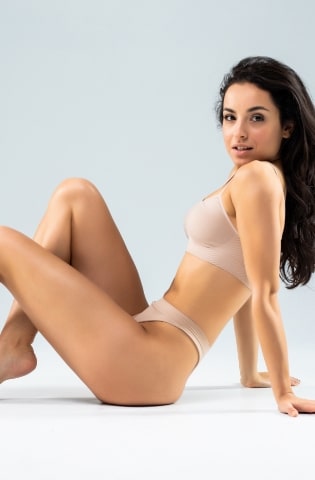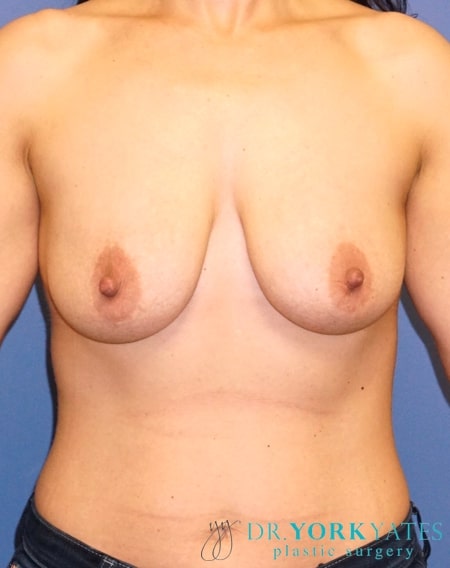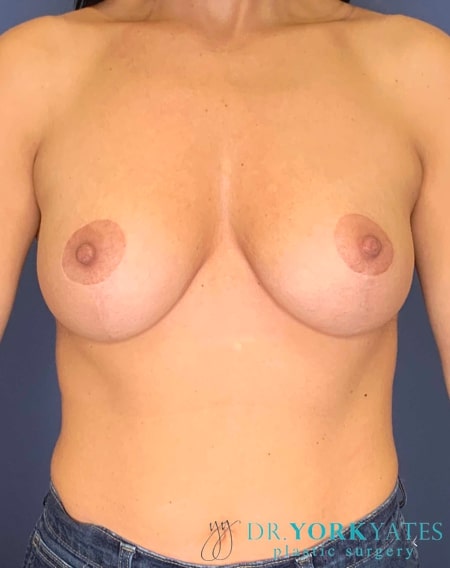
What is Fat Transfer to the breasts?
Fat transfers involve harvesting a patient’s adipose (fat) cells from an area of the body with unwanted fat, purifying the fat cells, and then re-injecting them into an area where more volume is desired. Fat transfer is an alternative to breast augmentation with implants for moderate size increase.
Breast fat transfer for breast augmentation is one of the hottest cosmetic breast procedures in Salt Lake City, Layton, and surrounding areas. Similar to Brazilian Butt Lift (BBL), fat is transferred from an undesired area to the desired area with the effect of completely changing the body shape. If the procedure is expertly performed, the fat becomes a permanent breast size and shape enhancer.
How does Fat Transfer to the breasts compare to Augmentation with implants?
Our breast fat transfer patients are excited by the prospect of enlarging their breasts without the use of breast implants. They like the idea of using their own body fat rather than a manufactured implant to increase their breast size.
So how do they compare?
- No danger of capsular contracture — The most common complication of breast implants is capsular contracture, where scar tissue forms around the implant and constricts it. This is not possible with fat transfer.
- No possible rippling — Implants can develop wrinkling that is visible on the breast surface—particularly saline implants on patients with inadequate soft tissue coverage. Implant rippling is not possible with fat transfer.
- Additional surgery — Breast implants have a lifespan, just like any manufactured item. They will need to be replaced every 10 – 20 years or so. Fat transfer is permanent, although not all of the transferred fat will “take.” The amount that does survive is permanent. Some patients desire additional fat transfer to achieve their size goals.
- Surgical scars — Implants are inserted through a surgical incision. Fat transfers are done with a syringe, and this leaves essentially no scars.
- Lose unwanted fat — Because fat transfer utilizes liposuction to remove fat from areas such as the lower abdomen or the flanks, the breast increase is accompanied by body contouring.
- Conservative size increase – If you desire to change your breast size dramatically, fat transfer may be inadequate. Fat transfer can give you a moderate size increase, usually 1 to 2 cups.
- Less predictability — With breast implants, you know exactly how your breasts will change. With fat transfer, not all of the injected fat cells will acquire a blood supply and “take.” The final size increase after the fat transfer is less predictable than an implant.
- Upper volume — Some patients want to add a lot of volume and roundness to their upper breasts. This is less dramatic with fat transfer. The results are more natural.
Before & After
Procedure:
32 year old female before and after breast rejuvenation with a skin envelope only breast reduction and fat transfer to the breast. A total of 200 cc per side was grafted. The lift was a skin envelope reduction only which was a good option for her as there is less risk of sensation changed and the upper fullness is able to be created by the fat transfer. The fat transfer volume remained stable after the three-month visit. View More.
Who is a good candidate for Fat Transfer to the breasts?
Good candidates for these procedures with Dr. Yates should want to increase their breasts by moderate amounts, typically no more than one cup size. Ideal candidates have areas of unwanted fat that can be removed with liposuction and used for the transfer. Candidates should also be attracted to the fact that they are not putting anything artificial in their body. The fat used is the patient’s fat and is simply purified. Good candidates for fat transfer to the breast have:
- Enough fat to harvest from undesired areas
- Nice skin in the areas where fat will be harvested for smooth liposuction results
- Breasts that are moderate in size. If the breasts are too small, there will be minimal size increase
- Breasts with good skin elasticity and minimal droop
Breast Augmentation by Fat Transfer or Breast Implants?
The results of breast augmentation by implants and breast augmentation by fat transfer are generally different. Patients who desire a natural breast size, natural breast shape, and have unwanted fat for harvest are the best candidates for breast fat transfer. Patients who want larger breast sizes or an exaggerated upper fullness may be better candidates for breast implants.
Hybrid Breast Augmenation. Implants AND Fat?
For thin patients who have minimal coverage over their implants and desire a softer, more natural appearance, we may consider a hybrid procedure that combines both implants and fat transfer. In this approach, a smaller implant is used, and fat is harvested and grafted into the breast area above the implant. This technique can provide better coverage, reducing rippling and creating smoother transition zones. Additionally, for some patients, the breast shape can be enhanced beyond what is achievable with an implant alone. For example, fat transfer is commonly used in the cleavage area to minimize the space between the breasts for certain patients.
A drawback of this procedure is the significantly higher cost and the additional recovery time required for the areas from which fat is harvested. However, for patients who are already considering liposuction, these disadvantages may become less significant.
A smaller implant can have advantages of lower complications such as bottoming out or stretch of the overlying tissues from weight and gravity.
What are the advantages of Fat Transfer for Breast Augmentation?
- Breast implant complications avoided including capsular contracture, rupture, malposition, and rippling
- Breast implant illness, a poorly understood and rare condition, not a concern
- No worry about implant imaging or future replacement surgery
- Fat grafting feels more natural (a positive for some patients, a negative for others)
What are the disadvantages of Fat Transfer Breast Augmentation?
- Breast augmentation volume increase is limited to around 1 – 2 cup sizes
- The breast size increase is less predictable
- Some patients want the roundness that can only be achieved with an implant
- The procedure is generally more expensive if multiple liposuction areas are chosen
What determines the breast size increase after Fat Transfer to breasts?
Imagine a sponge and a cup of water. The amount of water the sponge can hold depends on the size of the sponge. Similar is fat transfer. Larger breasts can keep more fat before they are full and can accept no more fat. It is unfair; patients with petite breasts can only get a modest increase in breast size. The size increase possible is typically about double the starting breast size. The good news is that the procedure is repeatable, and the new larger breasts can accept even more fat than the first fat transfer (the sponge is larger).
How long does a Fat Transfer to breast last?

top = before, middle = 3 months after surgery, bottom = 6 months after surgery. Fat transfer is stable after 3 months.
Breast augmentation with fat transfer is a permanent procedure. The transferred fat has a small degree of the initial loss, but the fat that survives the transfer becomes a new and living part of the breast permanently. As demonstrated in the photos, the grafted fat remains stable after approximately one to three months after surgery. Meaning, a patient should expect to maintain the results from that time forward. Forever!
What happens if I lose or gain weight?
Weight gains and losses will be noticed in the breasts, similar to fat elsewhere.
Is it possible to do Fat Transfer after I’ve had my implants removed?
Many women have been having their breast implants removed because of fears of various problems associated with implants. This includes the recent FDA requested recall of textured breast implants due to the risk breast implant-associated anaplastic large cell lymphoma.
It can be hard for these women to adjust to their dramatically smaller breasts again, even if a breast lift is performed by Dr. Yates to remove sagging skin. Fat transfer can maintain some of the size and fullness that was lost when the implants were removed. And it does so without any of the risks associated with implants.

How is Fat Transfer for Breast Augmentation done?
Fat transfer breast augmentation is essentially a liposuction procedure. The ideal fat to use for breast transfer is stubborn, difficult to lose fat. Rather than discarding the unwanted fat, it is collected into sterile canisters and transferred to the breasts. The fat should be purified before grafting to improve the degree of viable fat. Separation is accomplished by some combination of gravity, vibration, decanting or centrifugation. The fat is then transferred to the breast with fine cannulas. The amount of fat grafted depends on the size of the breast, tightness of skin envelope, and operative technique.
Dr. Yates may also use VASER liposuction fat transfer to assist with the liposuction portion of the procedure. This can help Dr. Yates achieve a more aggressive fat removal, particularly in thin patients and the quality of the fat harvested is very nice for “take” with fat transfers.
I’m skinny, do I have enough fat to transfer?
The amount of fat that can be transferred during augmentation is limited by two factors: 1) the available spare fat that can be harvested, and 2) the initial breast size. A minimum breast size of B cup or larger is preferable for grafting because very small breasts cannot accommodate as much fat transfer. Dr. Yates likens this to a very small sponge (breast) that simply cannot hold much water (fat).
For patients with inadequate fat for transfer, Alloclae is an option to consider. Alloclae is a new filler composed of human fat cells, extracellular matrix, growth factors, and collagen. It does not require liposuction for fat harvesting. This option is particularly suitable for patients who have minimal fat to transfer and are seeking small-volume augmentation. However, Alloclae is quite expensive, typically around $100 per cc for product cost alone, which is cost-prohibitive for most patients. To achieve Alloclae augmentation of a typical conservative breast augmentation size of 300 cc could cost in the range of $600,000! For this reason, it is used more practically for shaping rather than significant volume increases for most patients.
Alloclae is provided pre-packaged and ready for grafting without the need for anesthesia or liposuction. Its most effective applications include addressing contour irregularities, concealing the visibility of rippling or implant edges, modestly increasing nipple projection, or enhancing cleavage fullness in a conservative manner. Most of these applications will require closer to 25 cc of Alloclae and although expensive is more reasonable, in the $5000 range.
Alloclae requires no anesthesia, and almost no downtime with most patients resuming normal and full activity within a couple of days.
What is the recovery after Breast Fat Transfer?

The most difficult aspect of breast fat transfer recovery is the liposuction. The areas of harvest are generally the most tender, which can last for a few weeks. Most patients find they don’t need narcotic pain medications.
What are the risks of Fat Transfers?
Fat transfers are considered to be minimally-invasive procedures. The most common complications are tender nodules associated with fat that does not survive. These are known as fat necrosis, and technical modifications, including not overdoing the amount of fat transferred, can help minimize this complication. Fat necrosis can show up on mammograms but is rarely confused by radiologists for anything else.
Where should I go for Fat Transfer to breasts?
Simple in concept, but technically demanding, breast fat grafting is not a procedure for the untrained non-plastic surgeon. A comprehensive understanding of liposuction, soft tissue grafting, and breast aesthetics are necessary foundations for anyone attempting to perform this procedure.
Insist your physician is a board-certified plastic surgeon for something as important as your safety and cosmetic outcomes. To learn more, contact us today.
What is the cost of Breast Fat Transfer?
The cost of fat transfer to the breast is largely dependent on the areas of liposuction desired. If a patient has enough fat in a single area for fat transfer this can cost a similar amount as breast augmentation with implants. More liposuction areas typically cost more.
Office-Based Surgery Safety Information

We would be honored to have you as our next breast fat transfer patient. To schedule a consultation, call the office at 801.525.8741 or if you would prefer an online visit fill out a virtual consultation form. Dr. Yates will respond in a timely fashion to your inquiry.



